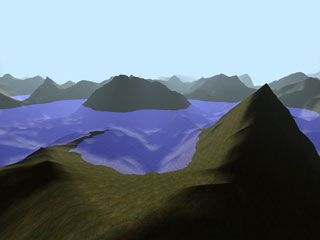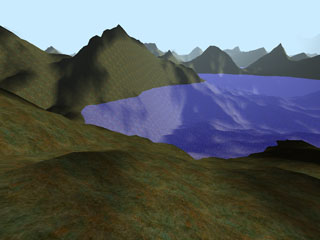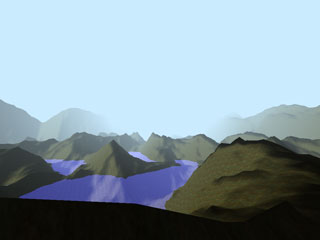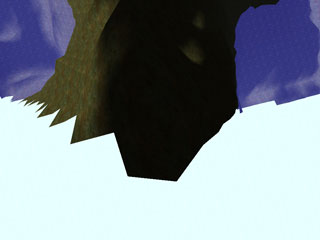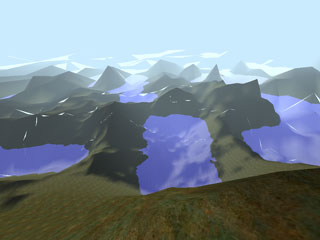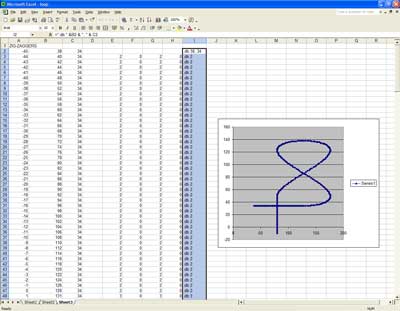Title screen goodness
Tuesday, 20th September 2005

I spent some time yesterday doing some 'fun' work on Fire Track - that's not to say that the other stuff is not fun, but I find the graphics work less head-hurting than the programming work.
Hence the spiffy title screen above! It was fun trying to fit that into 16 colours and able to be broken down into 256 tiles, but with a bit of shuffling around it's a mere 254 tiles and the GIF exporter in Photoshop has done a great job dropping down the colours.
The display on the Game Gear blends adjacent pixels together very nicely - on hardware, the title looks pretty flash. (It's difficult to get a good picture of Game Gear - you try taking a photo of a TV set and you'll see what I mean! As clear and sharp as your TV looks out the photo will usually look washed out or fuzzy). See, here is a screenshot of the game running in an emulator:

Not quite so smooth, is it? (Not to mention it's a different aspect ratio!) Still, it's a little more colourful than the original:

(Mine is a cleaned up version of the box cover with the text redrawn.)
As you can imagine, a title screen such as the above takes up a lot of space. 254 8x8 tiles means 254*8=2032 rows of pixels, each row is made up of 4 bytes (four colour bitplanes) giving us 8128 bytes or 7.94KB. Seeing as the ROM I'm using is only 32KB, things are going to get tight - not to mention that even without the title picture I get the following:
Building... (Sega Game Gear)
Setting base location 'D:\My Documents\Game Gear\Dev\Fire Track\'
Running batch job '"D:\My Documents\Visual Studio Projects\Latenite\bin\compile\Sega Game Gear.bat" ftrack.z80 ftrack "D:\My Documents\Visual Studio Projects\Latenite\bin\compile"'
Build process complete!
Bank 00 has 03729 bytes (11.38%) free.
Free space at $0029-$0065.
Free space at $7191-$7fdf.
Free space at $7ff8-$7ff9.
Free space at $7ffc-$7ffe.
3729 unused bytes of total 32768.
Erk! That's not much room at all, and I still need more space for the music. I need to jump to using 2 ROM banks - that'd give me a healthier 64KB to work in, and 48KB of that is set up to be directly accessible without any paging as default. Or so it goes in theory, but WLA-DX's syntax for defining memory locations/ROM bank setup has me totally stumped. Looks like I'll need to pester the SMS Power! chaps again. ![]()
Anyway, what is going on in Fire Track itself? I did do some coding last night as well as slacking off with some image editing, and these features are now implemented:
- Final attack pattern is in place - small ships appear then attack you by setting a direction when at a certain Y coordinate and just heading into you in a straight line. This is slightly buggy, some ships appear to have drunk pilots and veer off in completely the wrong location. Not sure why that is, but most seem to hit the target (read as: ME).
- Bugfixes/tweaks on a couple of the enemies. The ones that randomly drift towards you (the dumbell-shaped blockers and another formation) now only start drifting in X once they are on-screen, else they all appear on screen in a vertical column and it looks really silly.
- If you complete a level it doesn't just automatically jump to the next level, you lose control of your ship and it flies up and off the top of the screen. I shall probably also stop the end face from looping so that when you finish and have flown the background doesn't just disappear, it's as if you accelerate and it moves downwards off screen to the blackness of empty space.
- The sound! How could I forget that? It now works on volume rather than the hard-coded priority, and thus sounds very much better. (The loudest sound is the one that is played, as I can only set one period/amplitude as a sound effect at any one time).
- Fixed a bug on the title screen where sound channel #2 was not being set (channel #1 was set twice by accident).
Rather than just see a list of what's done, have a list of what is left to do as I am feeling generous. ![]()
- Get ROM paging correctly up and running so I can dump more data onto a second 32KB ROM chip.
- Add sounds for me exploding (uses the noise channel so isn't just a case of adding a new sound effect).
- Adding the "mine" enemy. This is a small spiky blobby thingummy (technical term) that drifts in a straight line until it hits the edge of the screen, at which point it reappears at a random location and drifts in a new, random direction. If it hits you, of course, you lose. You can see it in this screenshot of the BBC Micro version:
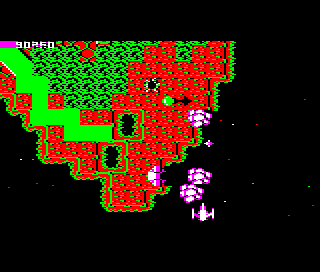
It's the thing above the two lower explosions. - Music. I need music. I also need a music system, so defining instruments (attack fade, play effect (vibrato?), release fade) and notes, as well as all sorts of other nasty music things.
- Scoring.
- Parallax stars? (Maybe, hopefully!)
- Lots of other things I must have forgotten.
Until next time! Incidentally, my journal is now listed as the News section on my website.
Minor progress
Monday, 19th September 2005
I've spent the last few days up North for a cousin's wedding, so not much has gone on regarding Fire Track.
A few things have been added, though!
The sound is now "mixed" (for want of a better word) much better. It's still not perfect, and I'd like to see how it sounds when favouring amplitude over priority. That'll be my next tweak!
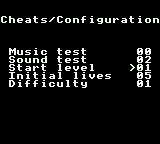
I have added the cheat screen (also useful for testing sound!) which will appear if you hold down certain keys as the game starts. There are a new set of enemies...
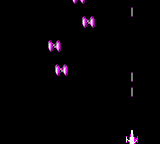
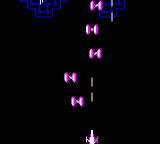
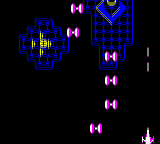
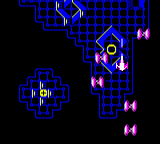
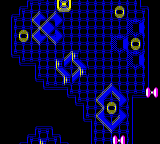
They just drift towards you - and you can't shoot them (they block bullets, though).
Also, the "final platform" for a few levels has been implemented. This is for the levels where you don't finish up with a face to shoot the eyes on, just a platform:
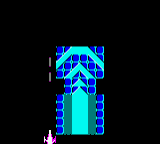
You need to drift past it to beat the level.
When you have finished the last level, the epilogue now plays too.
Through extensive testing (playing?) the original, I have worked out the purpose of the question mark blocks:
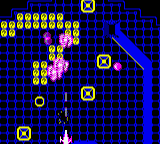
Shoot out a certain number and you get a funny noise and are awarded an extra life!
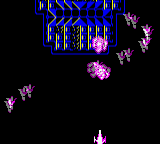
Motion blur filters are so cool. ![]()
Bloop-bleep, it's the 80s!
Wednesday, 14th September 2005
Sound! I am still musicless, but never fear, for sound effects will fill the gap. Screenshots are pretty poor for sound ![]() , so here's the MP3.
, so here's the MP3.
Simple as it sounds, that takes a mere 163 lines of ASM code to work, and even then it's a fairly crap effect!
Each sound is stored as a series of "fades". Each fade contains the following data:
- Starting period of the wave.
- Starting amplitude of the wave.
- Length of the wave in frames.
- Amount to add to volume each frame.
- Amount to add to period each frame.
Using these simple fades and joining them together you can very easily produce a fairly complex sound. There are currently only two sound effects, and both are a single "fade" long - one for firing, the other for when a tile on the ground has been hit.
Each sound effect is issued with a priority, in a little table, so that the most important sound is played over the top of the least important one. In this case, if you play a more important one over a less important one (higher pitched bleeps) it cuts the less important one out for good - which is rubbish, really. What I will have to do is to extend the system to act over a list of current sound effects that can be added to at any time. That way, which tone is sent to the PSG (the sound chip) can be decided at that point, based on priority (and maybe volume, I'll have to see how it sounds).
I fixed Latenite's ugly XP icon issue, and here are the results:
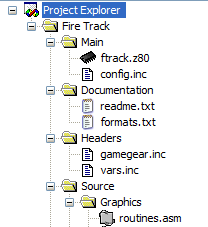
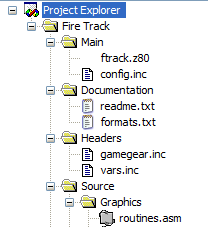
![]() The one on the left is the Debug build. The one on the right is the Release build. I have no idea why it is doing that on the right, or how I can fix it.
The one on the left is the Debug build. The one on the right is the Release build. I have no idea why it is doing that on the right, or how I can fix it.
It gets better.
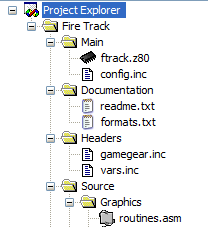
This is what it looks like in Release mode when running in the VS.NET IDE.
I shall now resist the urge to make an massive journal post this time. Honest. Just watch me. ![]()
Old projects and ugly XP icons
Tuesday, 13th September 2005
This is going to be a very boring update, I'm afraid. I wasn't feeling too good so haven't got much done. ![]()
First of all, Latenite updates. With the project thingummy, I thought it would be nicest if it displayed the proper Windows icons for file types rather than the ones I had hardcoded in. Here is a function I wrote to take a filename and return an icon (in the form of a .NET Bitmap) based on it and whether you requested a large or small icon.
It works by going into the registry and looking up the ".ext" key. Some keys like that contain a DefaultIcon property and a filename/index number of the icon to use, some just point at another subkey with that DefaultIcon property.
After I found that, I use the rather nasty ExtractIconEx to retrieve icon pointers from the DLL/ICO/EXE, select the one I want, copy that to an Icon (and then to a Bitmap) then clean up.
Here's a screenshot of it in action:
![]()
You'll notice the crud around the final icon. It seems that any XP-style icons with an alpha channel get mucked up by the ExtractIconEx ripping out the icon's data. If possible, I would force it to retrieve the 256 colour version (at 16x16, that's still a colour for every pixel!) but don't possess enough Win32 wizardry to achieve this. If anyone could help me, I'd really appreciate this.
Here is the module, in case someone finds it useful. Sorry if it appears a bit hacky, but it seems to work fine for me.
Module mdlIcons
Private Declare Function ExtractIconEx Lib "shell32.dll" Alias "ExtractIconExA" (ByVal lpszFile As String, ByVal nIconIndex As Int32, ByRef phiconLarge As Int32, ByRef phiconSmall As Int32, ByVal nIcons As Int32) As Int32
Private Declare Function DestroyIcon Lib "user32.dll" (ByVal hIcon As Int32) As Int32
Function getIconFromFilename(ByVal filename As String, ByVal largeIcon As Boolean) As Bitmap
' Grab the extension:
Dim getExtension() As String = filename.Split(".")
' Look up the file type:
Dim searchKey As Microsoft.Win32.RegistryKey = Microsoft.Win32.Registry.ClassesRoot.OpenSubKey("." & getExtension(UBound(getExtension)), False)
' Was anything found?
If searchKey Is Nothing Then Return Nothing
' Go through until you hit the end:
Dim getDefaultIcon As Microsoft.Win32.RegistryKey
Do
getDefaultIcon = searchKey.OpenSubKey("DefaultIcon", False)
If Not (getDefaultIcon Is Nothing) Then Exit Do
searchKey = Microsoft.Win32.Registry.ClassesRoot.OpenSubKey(searchKey.GetValue(""))
If searchKey Is Nothing Then Return Nothing
Loop
' Get the details:
Dim fileDescription As String = searchKey.GetValue("")
Dim iconPath As String = getDefaultIcon.GetValue("")
' Close the registry keys:
getDefaultIcon.Close()
searchKey.Close()
' Now we have that data, we need to convert a "xxxx,0" path into a "xxxx" and a "0"
Dim getPlainIconDetails() As String = iconPath.Replace("""", "").Split(",")
Dim iconIndex As Integer = 0
Dim plainIconName As String = getPlainIconDetails(0)
For i As Integer = 1 To UBound(getPlainIconDetails) - 1
plainIconName &= "," & getPlainIconDetails(i)
Next
If iconPath.Replace("""", "").ToUpper.EndsWith(".ICO") Then
If UBound(getPlainIconDetails) <> 0 Then plainIconName &= getPlainIconDetails(UBound(getPlainIconDetails))
Else
iconIndex = Val(getPlainIconDetails(UBound(getPlainIconDetails)))
End If
' Now we have all that info, let's grab the icon:
Dim iconLarge As Int32
Dim iconSmall As Int32
If (ExtractIconEx(plainIconName, iconIndex, iconLarge, iconSmall, 1) > 0) Then
Dim iconPtr As IntPtr
If largeIcon = True Then
iconPtr = New IntPtr(iconLarge)
Else
iconPtr = New IntPtr(iconSmall)
End If
Dim iconRes As Icon = Icon.FromHandle(iconPtr)
Dim returnBitmap As Bitmap = iconRes.ToBitmap
iconRes.Dispose()
If iconLarge <> 0 Then DestroyIcon(iconLarge)
If iconSmall <> 0 Then DestroyIcon(iconSmall)
Return returnBitmap
Else
Return Nothing
End If
End Function
End Module
The C# source code I saw that used the ExtractIconEx call used ExtractIconExA instead of ExtractIconEx. I thought that this meant that A = alpha, so hopefully swapped the A in but VB.NET complained with a squiggly blue line. If only Win32 was as easy as that.
As far as Fire Track itself goes, there's nothing to really show for it - if you die, the game continues for a short way (with you invisible and uncontrollable) before decrementing your lives by one and sticking you back at the zone info screen. When you press START you get stuck back in the game at your old position in the level and you start again.
As dull as that sounds, there is a lot of work going on to achieve that - namely swapping palettes and tilesets to RAM and ROM and back again as required.
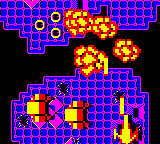
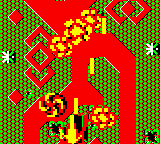
Here's a silly pair of screenshots. I played around with some of the more interesting VDP mode bits last night, and this is the "sprite zoom" one. By changing a couple of lines of the sprite routines with .ifdef blocks I can now set a switch in my config.inc file before compiling and all sprites are double size. Not sure why one would want to do that, but it's nice to know that the option is there.
Finally, here are some old shots I could have shown in here a while back - I thought I'd teach myself some OpenGL, what with SDL just sitting around doing nothing much for me.
As ever, click for bigger. Yep, it's the generic starter app of a terrain engine. (The Perlin noise for heights was new to me, I'd only used a precalculated one from Photoshop before). I couldn't quite work out how to do ambient lighting, hence the black sides to the hills. Not to mention that the tiling of the ground texture is blatently visible. The water moves up and down slowly to "wave", and the entire water texture scrolls past slowly.
I wish those shots were "real" - in face, there are two major flaws in my engine. First up is the very poor culling for terrain chunks outside the view - it's purely 2D, so looking down at the ground looks like this:
...which isn't quite right. I also had to tweak the LOD calculation for the above shots - here it is with the LOD tuned the other way;
Lots of nasty holes. I couldn't quite work out the skirting myself, so consigned the project to the bins once again (as I do with about 49 out of 50 projects). It runs at ~150FPS in debug mode, which is something to be pleased with I suppose.
I will release Fire Track, though. I hope. If someone could help with the music.
Lost projects... now there's an idea for a Lounge thread. I think I'll spare that by posting a few in my journal instead. Some of these started out as Really Good Ideas at 3AM when I couldn't sleep, but never seemed to get anywhere:
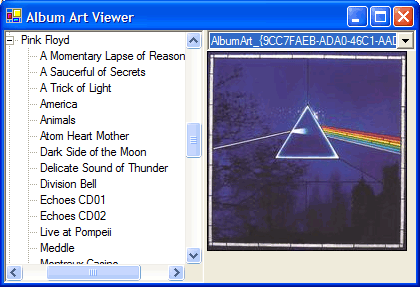
Album Art Viewer - for those covers that Windows Media Player displays, which Windows Explorer hides.
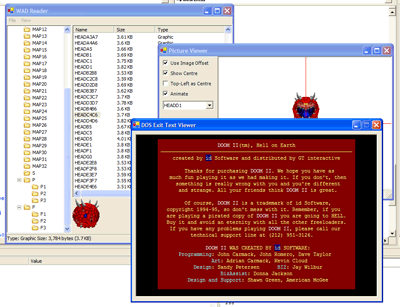
WAD Reader - DOOM WADfile reader/viewer. Has support for all graphics ("pictures" and raw flats), DOS end screens, PC speaker sound effects. Can view pictures in special viewer where you can rotate the sprites or watch their animations (it has to guess a lot, so that's not perfect). Can export all lumps as raw data or convert to PNG (graphics) or RTF (DOS end screens). Can also play the PC speaker (not wave) sound effects if your PC has a PC speaker on the motherboard. VB.NET, but quite fast. Full screen pictures take about 2 seconds to render as properly, though. However, once rendered all are cached internally for instant retrieval.
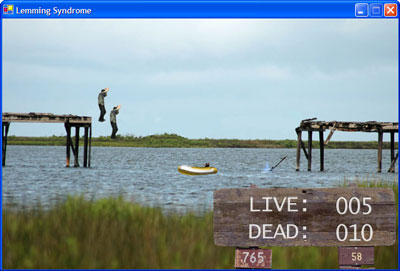
Lemming Syndrome - (click to download 194KB file, requires .NET runtimes) - wow! I forgot about this one. It was meant to be for the 1W1B contest - a challenge to work on a game for one week, with the requirement that you only used one button to control it. So, er, try and bounce me over the river in your lifeboat. There is no "game", as such, (unfinished), so it'll go on for ever.
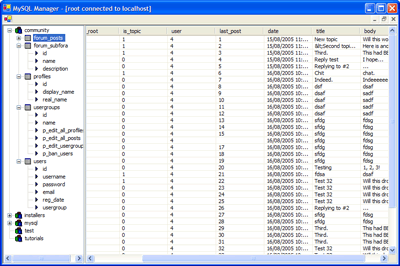
MySQL Manager - I was feeling cheap and my trial to MySQL-Front was about to expire, so I started work on a MySQL clienty thing. It's massively faster at downloading/displaying data, but that's about all it actually does after I decided it was too much hassle to try and recreate a full tool, so I forked out for a license of MySQL-Front instead. ![]()
Anyway, this is scaring me, I just found a garishly coloured TETRIS.EXE that I swear I never wrote, but the code style is mine and it has my name on it, so I guess I actually did... I have been feeling a bit ropey for the last year-and-a-bit, so I guess it slipped my radar. Or I wrote it in my sleep. Or something. Just be glad I don't have an internet connection myself and have to rely on one at work, so you're safe from me posting in my sleep! ![]()
On the merits of Excel and running out of space
Monday, 12th September 2005

Latest video. [2.29MB AVI]
You chaps probably don't know what a major headache it is trying to get clear, non-wobbly video... ![]()
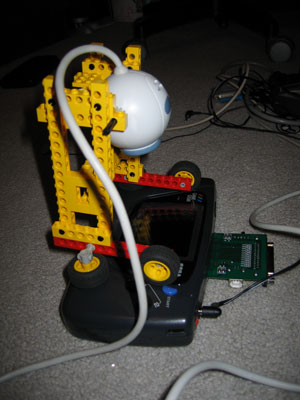
I gave up in the end and went for the "propped-up against a wall with camera on stack of books" approach. The reason I cannot, therefore, appear to play the game very well is because I cannot see the screen. All I can see is a faint, inverted glow and have to guess where I am. Not fun.
Here are the major updates since last time:
- Removed Blackadder theme

- Altered colour contrast on title screen, added wipe to clear it in imitation of original, restructured code for better fades, changed timing, added sound. Title screen is now complete.
- Rewrote entire code for checking bullet collisions with buildings on the ground from scratch. It now works perfectly.
- Levels now "start" correctly, so the ship moves in from the bottom, the start platform moves towards you very fast until they are in the correct positions, at which point gameplay commences (much smoother than just dumping you at the start position with a full level already there).
- All levels now mapped correctly, in order, with correct palettes for backgrounds AND sprites. Levels that end a zone with a platform rather than with the face are flagged as such and the correct end is substituted in now.
- Each level can be pointed at a 'replacements' table, which lists "replace tile X with tile Y". Tiles are swapped around properly so that levels appear more varied.
- Explosions are now fully implemented (2 kinds, background and foreground - with very slightly different animations) and working.
- Path-based enemy attacks are now in full working order, using paths generated with a combination of my graphical calculator and Excel.
- A couple of other new enemy attacks have been added.
- The game now sports a BBC Micro font which can be used for proper text display.
- The "epilogue" to the game is fully coded (type-writer effect for final message copied from original game, including sound effects and fades).
- Each level now begins with a summary screen (sprite limits meant that displaying all your lives at the start of the level was impossible, so is now done on an interval screen). The screen displays the zone name and a number of lives, the number of lives being surrounded by orbiting space-ships (the number of those being the number of lives left).
- The game now fully works on hardware (should now work on old hardware - not checked, as I do not have an old BIOS-less Game Gear) and in all emulators (I was not initialising the display correctly).
- Destroyed terrain tiles are not updated live to the name table in the fairly intesive loop - they are saved to a list of destroyed tiles, which are then read off directly and updated when needed in the intensive graphics bit.
I've probably forgotten a lot of stuff. Bear with me.
There have been a number of "WTF" moments reading back some of the source. Take, for example, this gem:

Some explanation is needed here - this is from the code that handles the special case when you have shot a 2x2 square building and it lies out of bounds of the name table. The name table is my grid (32x28) of tiles indices that each point to an 8x8 tile in the VRAM. As the view point moves up this map, new tiles indices are written to it, or old ones are adjusted when something is blown up. The worst case scenario here is if the 2x2 tile lies just above the top of the name table - which is what the above code has to fudge. Look at this:
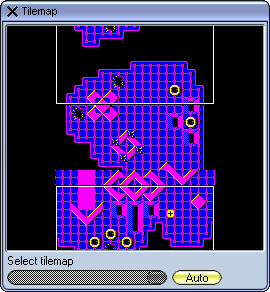
(I love debugging emulators!)
This shows all of my 32x28 tilemap. That funny white rectange is my view rectangle (it's currently half-off the display, and it loops around). If you look at the top and bottom edges of the tilemap, you'll see a ring has been shot out. Naturally, the bottom will have been hit first. What happens in this case is the address of the tiles that have been erased is decremented by a whole row of map points (there are 2 bytes to a spot on the name table, so I go backwards by 64). In this case, I find that the address is above the start of the tilemap so I add on 64*28 (which is the entire size of the table) and add it back to get back into the bounds of the table itself. As you can see, it was a successful operation in this case, but only because I was writing back HL this time and NOT the accumulator! No wonder my sprites were becoming destroyed as I was writing in completely the wrong part of the VRAM...
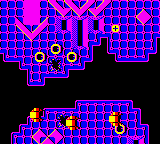
This is the screenshot from the emulator of the screen display for the above tilemap (the sprite layer is not displayed in the tilemap, for obvious reasons).
I'm still not getting very far with my quest for music. ![]()
The only bit of the game that has music is the title screen, and that's not so much music as a weird noise (here is an MP3 of my Game Gear's rendition, this is the original from the BBC Micro). Even though I have specified that the noise channel (the one that produces the high beeping noises) to use the highest frequency, it's still lower than the Beeb. All the other notes are correct, though.
Latenite has got yet another update - project support. (It looks more and more like VS.NET every day!) Rather than create messy proejct files and stuff which makes distrubution tougher, I thought I'd go the easier route of just allowing people to stick directives in the file with the ;#latenite:main directive. You can now ;#latenite:name="name_of_project" and ;#latenite:project="file_name"[,"project_folder"].
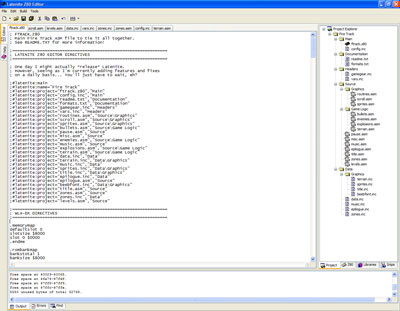
Click for larger image
Skybound Visualstyles (which I'm using to fix the weird .NET XP interface bugs) looks lovely but hugely slows down the app - only really noticeable with so many hundreds of nested controls like me and when moving large windows on top of it forcing repaints, so now the XP styling option is saved away (so you can revert to boring standard grey if you like). Latenite now saves window/splitter positions when you close - a first for an app by me! ![]()
In fact, Latenite is also my first app that needs a splash screen, it takes so long to get going... ![]() It's only about 2 seconds, though, for it to track down all the tools, load all the documentation, add all the compiler scripts and present itself, so it's not too bad.
It's only about 2 seconds, though, for it to track down all the tools, load all the documentation, add all the compiler scripts and present itself, so it's not too bad.
One overlooked piece of software is Microsoft Excel. People seem to develop a hatred of it, especially in people who end up trying to use it as a database application (it appears that this is what 9 out of 10 smallish (and some not so small!) companies do).
I have been using Excel to create those smooth curving paths for some of the enemies to follow. First, I prototype them on my graphical calculator (lots of trial and error involved!):
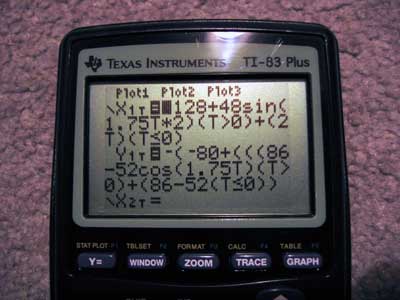
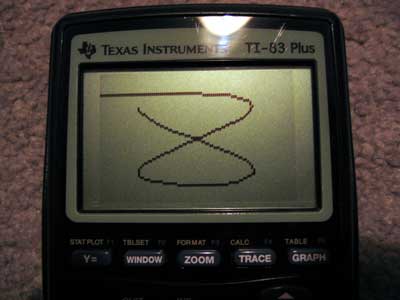
..before transferring into an Excel spreadsheet.
The Excel spreadsheet is set up so that column A is the steps (usually 0 to 256) in ascending order. Column B is the X coordinate, column C is the Y coordinate.
Columns E and F serve a special purpose - they contain the differences between each element in columns B and C (so E3=B3-B2, E4=B4-B2 and so on). Columns G and H "fix" the values - if it's negative, make it positive and set the fourth bit (just add 8). This is for the internal representation of the paths. Column I contains the data I can just copy and paste into the source files - it starts with the initial (x,y) coordinate, and then has a list of bytes. Each byte signifies a change in (x) and change in (y), with the lower four bits for (x) and the upper four bits for (y).If the nibble is moving the object left or up (rather than right or down), then the most significant bit of that nibble is set. For example:
%0001 - move right/down 1 pixel
%0011 - move right/down 3 pixels
%1001 - move left/up 1 pixel
%1100 - move left/up 4 pixels
...and therefore...
%11000001 = move right one, up four.
Poor Excel has suffered a little bit of neglect from me - I used to use it to generate my trig tables. WLA-DX, the assembler I learn to love more and more every day, supports creation of a number of different tables - including trig tables - with a single directive. Just specify .dbsin (or .dbcos) followed by the start angle, how many bytes of trig table you want, the step between each angle, the magnitude of the sine wave and the DC offset and away it goes.
People still using TASM, STOP! Use WLA-DX. It's ace (and free, not shareware!).
You can never have enough pictures in a journal (hey, you should see this page load on our 700 bits/sec phone line at home!)
Here's the full list of sprites:
![]()
The last ship being after the explosions is a mistake, but it's too much hassle to change. I'm really pleased the way they've come out - I'm no pixel artist. ![]()
I'll finish off with a few assorted screenies.
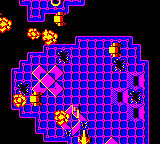
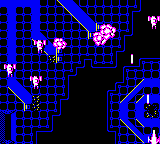
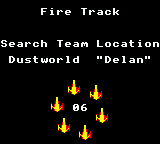
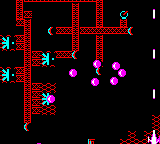
...I would have done. I should have done. However, when taking those screenshots I saw a glitch in the graphics. As an exercise for the reader, can YOU spot where the bug is?

(and it's not in one of those external functions I wrote - this is why copy-paste coding is bad, 'kay?)
Oh, (possibly?) final last thought popping into my head: one thing I really miss from the BBC Micro era is the comfortable keyboard layout. I mean, look at this small photo of a Master 128 keyboard:
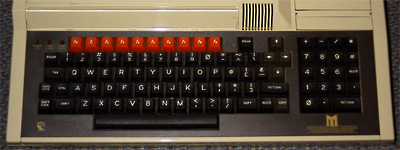
Click for bigger
You might think that that blocky monstrosity would knacker your fingers, but that's not the reason. It's the fact that rather than squash one hand's fingers onto a small cursor pad (or the even sillier WASD), you balance movement between your two hands - Z and X for left and right, : and / for up and down. (On a modern UK layout, that'd be ZX and '/). The space bar is now conveniently accessible by both thumbs, and you can reach around most of the rest of the keyboard with your other fingers.
The Game Gear is an ergonomic handheld (unlike the uncomfortable Game Boy), so I'm reckoning that I can balance the controls between hands - ← and → on the d-pad can control left and right, and the 1 and 2 buttons can control up and down. I will offer multiple layouts, though, as otherwise that might confuse some people. ![]()
Anyway, I hope you find this journal interesting. It seems a bit all over the place - video, pictures, rambling, odd bugs, nostalgia... The only thing that's an issue is my rapidly shrinking GDNet+ account web space!
